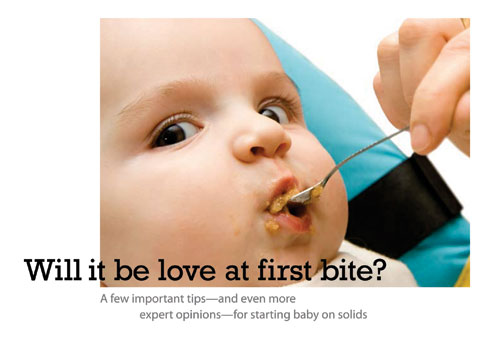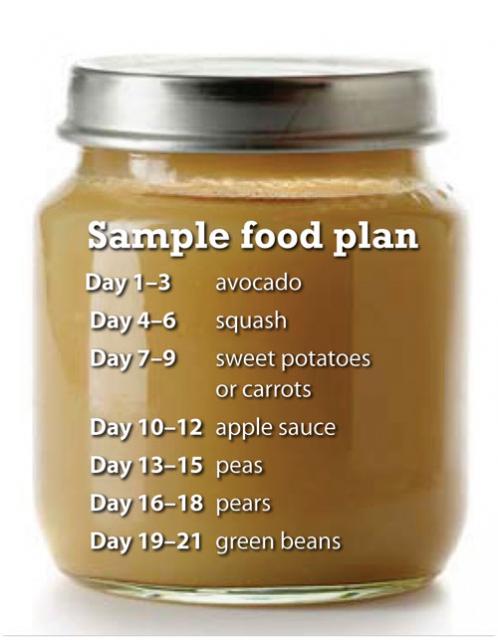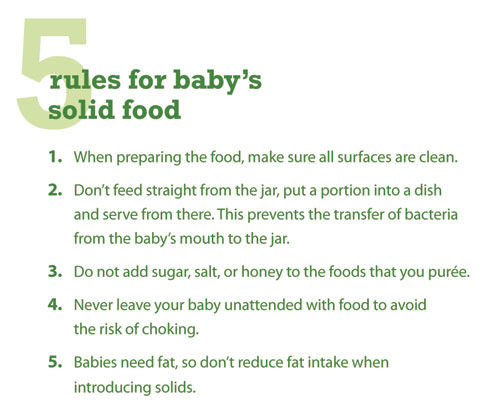 You’re likely to receive more advice and help regarding the first few months of parenthood than you know what to do with. And now here they go again, those well-intentioned family, friends, and neighbors telling you that your baby is ready for solid foods. So how do you know when your baby is ready for this transition?
You’re likely to receive more advice and help regarding the first few months of parenthood than you know what to do with. And now here they go again, those well-intentioned family, friends, and neighbors telling you that your baby is ready for solid foods. So how do you know when your baby is ready for this transition?
No, not even I can tell you when it’s time. Sorry folks, but this one comes down to you trusting your gut (excuse the pun) and paying more attention to your baby’s cues than that calendar everyone keeps reminding you of. That’s not to say first feedings don’t come with a healthy measure of trial and error as well.
Make your best guess
The American Academy of Pediatrics recommends that you offer nothing but breast milke and/or formula until baby is at least 6 months old. Your grandma and neighbor will tell you 3 to 4 months, but, on average, most babies start solids between 4 and 6 months.
I suggest looking for some of these cues to indicate if your baby is ready for real food.
- Baby is able to eat sitting up and has good control of his head.
- Baby’s showing an interest in the food on your plate and grabs at your fork or your food.
- Baby’s tongue does not stick out, she can keep food in her mouth, and move it to the back of the mouth and swallow it. This indicates the loss of tongue-thrust reflex.
- Her mouth opens easily when a spoon touches the lips or if food is being offered.
- Baby wakes often during the night, or wakes earlier and earlier in the morning after having a regular sleep routine.
- Baby’s showing an interest in the food on your plate and grabs at your fork or your food.
Taking the plunge
So, once you decide to try baby on solid foods, pick a time when both you and baby are relaxed and rested. And make sure she isn’t too hungry either— try after she’s had a good portion of her normal feeding. Even though this is an exciting time, it can also be stressful. You don’t want to be too eager or too stressed, so plan to take the time and come at it with the right attitude; basically, lower your expectations that baby wil be overjoyed and tuck in to a full meal. That is not likely to happen.
![]()
You’re ready once you have set up the high chair with the thinned-down, fortified infant rice cereal, which you’ve mixed with boiled and cooled water, formula, or breast milk; two clean spoons; a bib; and a wet washcloth. After you’ve tested the food’s temperature by touching a small amount to your lips, feed baby the first small spoonful. Bam— he’ll probably spit it out.
Oh no! Rejection and a look of total bewilderment on baby’s face! Do not lose faith. Be patient; try again. If baby seems to be having a hard time with spoon-feeding, try rubbing a little food on his lips with a clean finger, or letting him suck some cereal from your finger to get used to the flavor and texture.
Next time you try the spoon, slowly put the spoon inside the mouth — up against the roof of his mouth — and gently pull the spoon up and out, so that the gums help remove the food. This will help baby to grasp the new art of swallowing form a spoon and not just sucking from a breast or bottle, which is the only thing baby has been used to these past months.
Remember to smile and be positive: If you look like a deer in the headlights, then he’s going to pick up on that anxiety and not be relaxed.
Beyond rice cereal
Once baby masters cereal, you can start to introduce soft-cooked, thinly pureed vegetables and fruits. Offer a single ingredient, one new food at a time, for three days. This helps baby get used to the new taste and enables you to monitor his tolerance and acceptance of the food, as well as ensure he doesn’t have an allergic reactin, which usually comes in the form of diarrhea, or a rash on body and face.

I suggest trying vegetables before fruits. I am one of those people who believes that if you give the more savory foods first, you don’t run the risk of the baby only wanting fruits and developing a sweet tooth.
If your baby refuses a food, stop feeding, but try another food and then re-introduce the refused food at a later date. I believe the bigger the food repertoire at an early age, the better eater you’ll have futher down the line-not one of those fussy eaters that only easts chicken nuggets or hot dogs.
And remember to keep smiling. A happy mom equals a happy baby.

 Nanny Stella, celebrity family consultant, author, and star of Nanny 911, is well-known for her no-nonsense approach in helping families. Her passion is children— all ages, sizes, genders and ethnic backgrounds.
Nanny Stella, celebrity family consultant, author, and star of Nanny 911, is well-known for her no-nonsense approach in helping families. Her passion is children— all ages, sizes, genders and ethnic backgrounds.


Leave a Reply